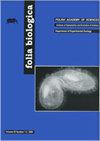Molecular Characterization, Tissue Distribution, and Expression Profiling of the CTSD Gene during Goose Ovarian Follicle Development
IF 0.8
4区 生物学
Q4 BIOLOGY
引用次数: 1
Abstract
Cathepsin D (CTSD) is known to be crucial for the degradation and utilization of yolk precursors in ovarian follicles. However, little is known about its expression profiles and physiological actions in avian ovarian cells. In this study, the intact coding sequence of the CTSD gene in geese was cloned for the first time, with a length of 1197 bp. It encoded a polypeptide of 398 amino acids (AA) consisting of a signal peptide and two conserved functional domains (i.e., A1_Propeptide and Cathepsin_D2). The AA sequence of goose CTSD had > 96% similarities with the homologs of turkeys, chickens, and ducks. Results from real-time PCR showed that goose CTSD mRNA was present in all tissues examined, with higher levels in the adrenal gland, liver, heart, and reproductive organs. Furthermore, levels of CTSD mRNA were much higher in goose granulosa layers than in the theca layers in any follicular category. Significantly, its expression remained almost unchanged in the theca layers throughout follicle development, while it increased gradually in the granulosa layers from 2-4 mm to F5 follicles but declined there after. These results suggested that CTSD may regulate goose ovarian follicle development through its actions on both the degradation and absorption of yolk precursors and granulosa cell apoptosis.鹅卵泡发育过程中CTSD基因的分子特征、组织分布和表达谱分析
组织蛋白酶D (CTSD)在卵泡卵黄前体的降解和利用中起着关键作用。然而,对其在禽卵巢细胞中的表达谱和生理作用知之甚少。本研究首次克隆了鹅CTSD基因的完整编码序列,全长1197 bp。它编码一个398个氨基酸(AA)的多肽,由一个信号肽和两个保守功能域(即A1_Propeptide和Cathepsin_D2)组成。鹅CTSD的AA序列与火鸡、鸡、鸭的同源性相似度> 96%。实时荧光定量PCR结果显示,鹅CTSD mRNA在所有检测组织中均存在,在肾上腺、肝脏、心脏和生殖器官中表达水平较高。此外,鹅颗粒层的CTSD mRNA水平远高于任何卵泡类别的卵膜层。值得注意的是,在卵泡发育的整个过程中,其在卵泡膜层中的表达几乎没有变化,而在颗粒层中,其表达从2-4 mm到F5 mm逐渐增加,但随后下降。上述结果提示,CTSD可能通过影响卵黄前体的降解和吸收以及颗粒细胞凋亡来调节鹅卵泡发育。
本文章由计算机程序翻译,如有差异,请以英文原文为准。
求助全文
约1分钟内获得全文
求助全文
来源期刊

Folia Biologica-Krakow
医学-生物学
CiteScore
1.10
自引率
14.30%
发文量
15
审稿时长
>12 weeks
期刊介绍:
Folia Biologica (Kraków) is an international online open access journal accepting original scientific articles on various aspects of zoology: phylogeny, genetics, chromosomal studies, ecology, biogeography, experimental zoology and ultrastructural studies. The language of publication is English, articles are assembled in four issues per year.
 求助内容:
求助内容: 应助结果提醒方式:
应助结果提醒方式:


